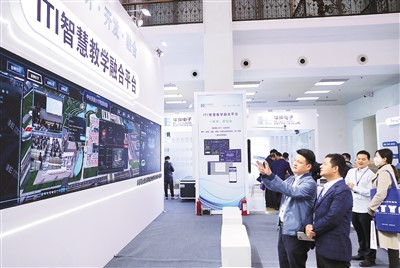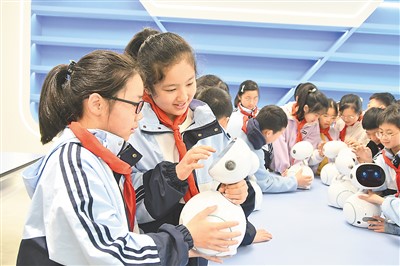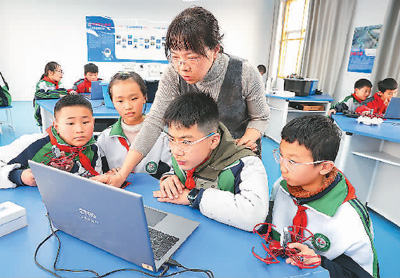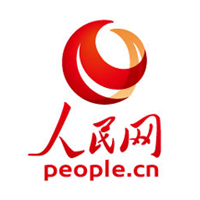 |
At the 33rd (2024) Beijing Education Equipment Exhibition, the audience visited the smart teaching integration platform.
Photographed by Zhang Xiuke (people's picture) |
 |
The students of Lizhu Robot Club of Mingzhu Primary School in Jiande City, Zhejiang Province experienced operating robots under the guidance of teachers.
Photographed by Ning Wenwu (people's picture) |
 |
In the artificial intelligence classroom of Yangkou Central Primary School in Guangfeng District, Shangrao City, Jiangxi Province, students carry out AI science popularization courses under the guidance of teachers.
Photographed by Zhu Wenbiao (people's picture) |
In the classroom, the online large electronic screen can access high-quality courseware resources at any time; On the playground, intelligent sports equipment makes 10 minutes between classes more interesting; Turn on your mobile phone, and all kinds of campus data and information are available... Smart campus is full of science and technology.
At present, the national education digitalization strategic action has been steadily promoted, and the campus informatization construction is moving towards a new stage of smart campus with application integration and innovation. Schools at all levels and all types actively explore the construction of smart campus, open up new forms of education, improve the digital literacy of teachers and students, and let digital technology serve the comprehensive education.
Infrastructure, equipment and environment are basically completed
In a primary school in Dongcheng District, Beijing, fifth grade students are taking a course of "Bo Wu Yan Xue". On the intelligent interactive screen in the classroom, the rear mother of large bronze ware Wuding is clearly displayed.
Student Xing Chenyang gently slides his finger on the interactive screen, and the rear mother Wuding rotates with it. "360 degree display!" Xing Chenyang said, "Even if you visit the museum, it is not easy to see the full picture because of the influence of the display cabinet and lighting. Now we can zoom in on the screen in HD to explore every detail."
"Using multiple technologies such as augmented reality, virtual reality and cloud based digital computing, we have digitally transformed the resources of Chinese excellent traditional culture enlightenment courses, introduced museum virtual scenes, and built an immersive, interactive, and experiential classroom." Guo Zhibin, vice principal of Shijia Primary School, introduced that the new teaching scenes allow learning to go beyond browsing and listening, It can also cultivate students' ability to observe, think, solve problems and express ideas, and promote the development of core literacy.
In the field of vocational education, which pays more attention to practical operation, intelligent equipment has substantially improved the teaching quality.
In the national vocational education virtual simulation demonstration training base in Nanchang, Jiangxi Province, the simulation airport tower, aircraft model, engine model and other equipment are available. "Wearing training glasses and holding the operating pen, you can see the internal structure of the machine equipment, and you can also do the disassembly and assembly, which is very real and intuitive." The relevant person in charge of the development and operation department of the training base introduced that the virtual simulation training allows teaching to break through the space constraints, so that students can improve their skills in low-cost repeated training.
The construction of smart campus is inseparable from the continuous improvement of infrastructure. China's smart education infrastructure and equipment environment have been basically completed. "Relying on the gigabit optical network, 5G and other network infrastructure, the smart campus has realized the extensive connection between teachers and students, equipment, and educational resources," said Zang Lei, deputy chief engineer of the Institute of Technology and Standards of the China Academy of Information and Communications, "The new teaching methods provided by the smart campus, such as online teaching, holographic classroom, virtual simulation experiment and training, integrate high-quality curriculum resources and situational thematic resources into daily teaching, provide students with real and vivid learning scenes, and build a learning model that transcends the boundaries of physical classrooms and campus."
Data analysis and multiple applications are continuously enhanced
In the physical education class of Dinglan No. 2 Primary School in Hangzhou, Zhejiang Province, while students are practicing standing long jump, the intelligent sports system on the side is also capturing the key nodes in the process of students' takeoff, landing and jumping in all directions and in many details through six high-resolution and high frame rate cameras.
"The arm angle is too small", "the take-off speed is too slow", "the single foot landing"... The system automatically recognizes students' actions and reminds them to improve.
"The intelligent sports system can not only realize the automatic collection and analysis of movement data, but also generate a report based on the students' movement completion. According to the report content, teachers have a scientific basis for class, and teaching evaluation will be more accurate." Li Qingli, deputy director of the Education Information Resource Center of Hangzhou Shangcheng District Education College, said.
Data is a key element in the construction of smart campus. Effective data analysis and application can help to understand the status of students, realize personalized services, find teaching problems, and help scientific decision-making.
In Tianjin No. 19 Middle School, the shared space in the middle of the teaching building is the most popular leisure area for students. The headmaster Lu Dongmei shared the story of the school using data information to do a good job in project construction.
"Each of our students has a campus card, which can borrow books from the drifting bookcase in the school. The drifting bookcase has both borrowing and track collection functions, and every time students pass by with the campus card, they can collect a data." Lu Dongmei introduced, "Data helps us identify students' behavior habits and social needs. According to track data, we have built a shared space in a certain area in the middle of the teaching building with the most passes and the longest stay."
Focusing on education big data enabling education and teaching reform, and giving full play to the supporting role of data on smart campus, the construction of national education digital big data center has started. "On the one hand, we will extend the scope of monitoring the operation of the national smart education platform and expand the depth of monitoring; on the other hand, we will build a data governance platform to enable all kinds of management services through various government data sharing, innovative application scenarios such as new student registration, precise funding, smart ideological and political, campus security, etc." said the relevant person in charge of the Department of Science, Technology and Information Technology of the Ministry of Education.
Rapid response to diverse needs of teachers and students
Open the small program of "Smart Academy" of Fudan University, "Chen Wangdao's Former Residence Visit", "Seal Cutting Workshop Seal Cutting Experience Activity", "The Fifth Basketball Training Camp"... various latest campus activities come into view.
"Click on the relevant links, and you can make an appointment to participate, which is very convenient." Zhang Zixuan, a 2021 undergraduate of the Department of History, said, "The 'Smart Academy' provides rich campus information, and allows teachers to interact with students; browsing, organizing or participating in activities can obtain different points to exchange for the cultural and creative products of the Academy, which improves everyone's enthusiasm."
"We hope to create a convenient window for the publicity of the Academy, a unified entrance to the Academy's activities, and a good interface for teacher-student interaction by building lightweight small programs." Ai Zhu, director of the Student Affairs Department of the Party Committee of Fudan University, introduced that based on the talent training goals and student growth needs, we are developing new functions of automatic and accurate promotion of educational resources, Improve the accuracy of matching resources with students.
The application of smart campus is also reflected in smart services and smart management. Zang Lei said: "By upgrading the campus management service platform and building a one-stop integrated information system that is interconnected, it can not only provide high-quality services for teachers and students to respond quickly, but also help improve the management decision-making ability of the school."
After the activity, the supplies can be sorted and put back in place soon. The application program developed by Shanghai Jianqing Experimental School makes the name, picture, quantity and other information of each teaching aid clear at a glance, which is not only convenient for access and use, but also provides a reference for schools to purchase supplies and teachers to select equipment; The smart venue reservation system of Harbin Institute of Technology has greatly improved the use efficiency of stadiums and gymnasiums... Now, the smart campus that everyone participates in, builds and enjoys is becoming a new normal.
"At present, educational informatization enterprises on the supply side have launched a wealth of smart campus products, but many products have not yet touched the real needs and pain points of campus users, and the scene design and business capabilities still need to be improved." Zang Lei said that we should strengthen the supply and demand docking, accelerate the development of customized smart campus products, and better match the diversified needs of schools, Improve the use experience of teachers and students.
(Editor in charge: Hao Mengjia, Li Fang)
Share to let more people see







































